DTH107 Determine Health: Care Action Plan - Case Study Analysis
VerifiedAdded on 2023/06/18
|21
|5191
|453
Case Study
AI Summary
This DTH107 assignment presents a case study requiring the analysis of a patient's health information and the development of a care action plan. The case focuses on Rob Carrington, a 53-year-old male with Type II Diabetes, obesity, and other health issues. The assignment involves identifying acute and chronic conditions, analyzing affected body systems, understanding normal anatomy and physiology, recommending diagnostic tests, and proposing conservative medical care interventions. The student addresses questions related to Rob's symptoms, potential diseases, and the impact of medical and surgical treatments, demonstrating an understanding of pharmacological processes and interdisciplinary team roles. This comprehensive analysis provides a structured approach to managing Rob's health issues, emphasizing both medical and lifestyle interventions.
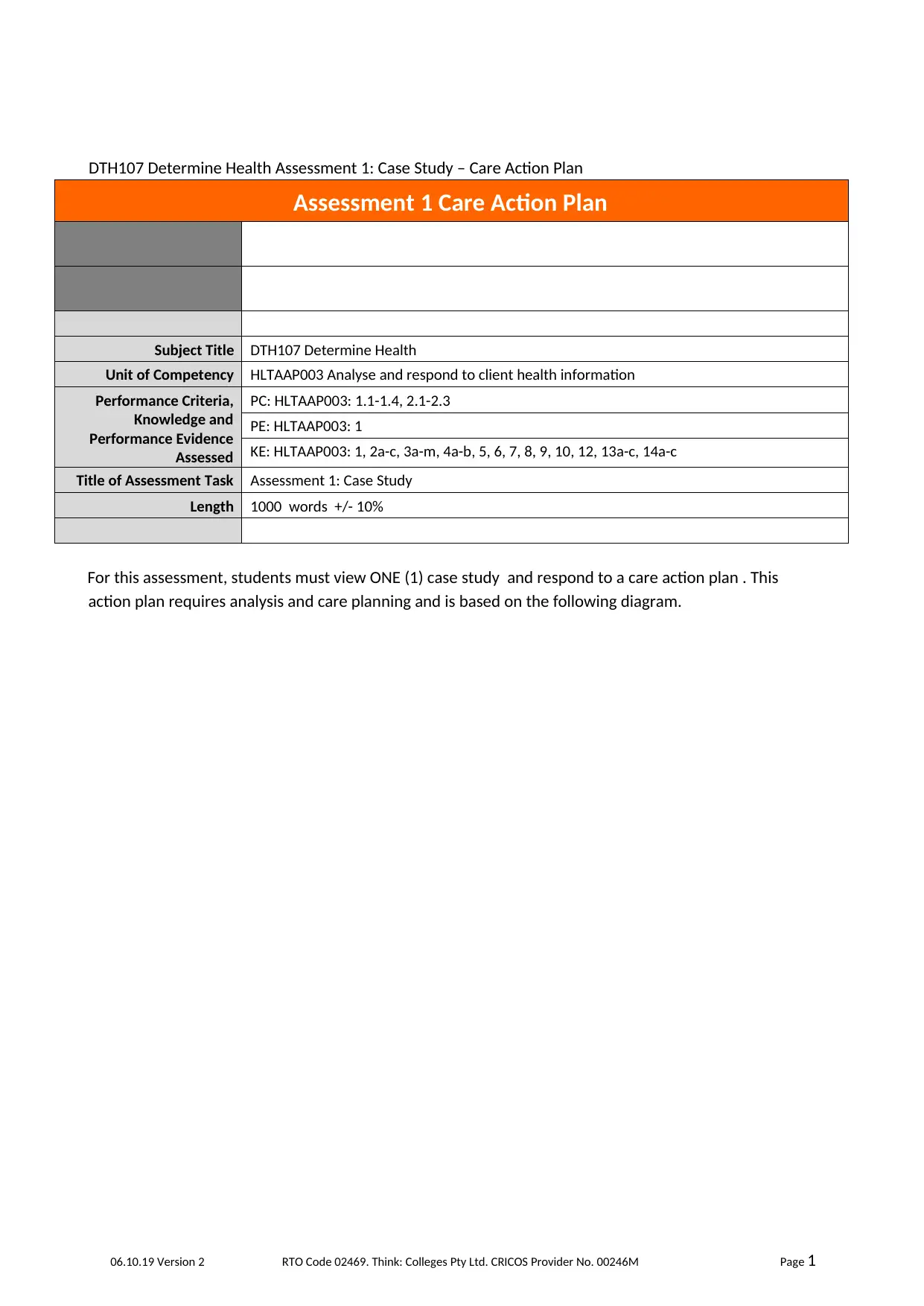
DTH107 Determine Health Assessment 1: Case Study – Care Action Plan
Assessment 1 Care Action Plan
Subject Title DTH107 Determine Health
Unit of Competency HLTAAP003 Analyse and respond to client health information
Performance Criteria,
Knowledge and
Performance Evidence
Assessed
PC: HLTAAP003: 1.1-1.4, 2.1-2.3
PE: HLTAAP003: 1
KE: HLTAAP003: 1, 2a-c, 3a-m, 4a-b, 5, 6, 7, 8, 9, 10, 12, 13a-c, 14a-c
Title of Assessment Task Assessment 1: Case Study
Length 1000 words +/- 10%
For this assessment, students must view ONE (1) case study and respond to a care action plan . This
action plan requires analysis and care planning and is based on the following diagram.
06.10.19 Version 2 RTO Code 02469. Think: Colleges Pty Ltd. CRICOS Provider No. 00246M Page 1
Assessment 1 Care Action Plan
Subject Title DTH107 Determine Health
Unit of Competency HLTAAP003 Analyse and respond to client health information
Performance Criteria,
Knowledge and
Performance Evidence
Assessed
PC: HLTAAP003: 1.1-1.4, 2.1-2.3
PE: HLTAAP003: 1
KE: HLTAAP003: 1, 2a-c, 3a-m, 4a-b, 5, 6, 7, 8, 9, 10, 12, 13a-c, 14a-c
Title of Assessment Task Assessment 1: Case Study
Length 1000 words +/- 10%
For this assessment, students must view ONE (1) case study and respond to a care action plan . This
action plan requires analysis and care planning and is based on the following diagram.
06.10.19 Version 2 RTO Code 02469. Think: Colleges Pty Ltd. CRICOS Provider No. 00246M Page 1
Paraphrase This Document
Need a fresh take? Get an instant paraphrase of this document with our AI Paraphraser
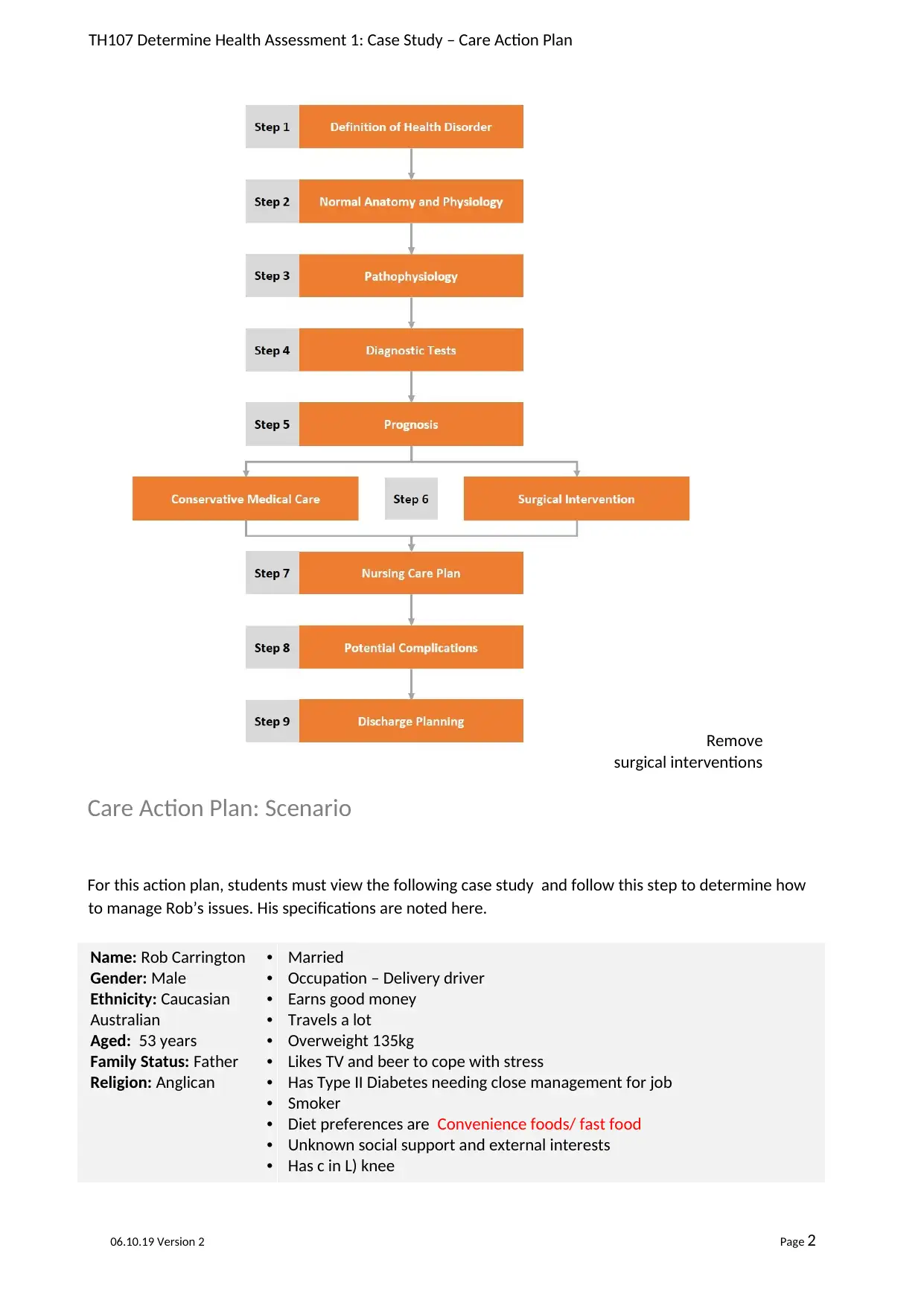
TH107 Determine Health Assessment 1: Case Study – Care Action Plan
Remove
surgical interventions
Care Action Plan: Scenario
For this action plan, students must view the following case study and follow this step to determine how
to manage Rob’s issues. His specifications are noted here.
Name: Rob Carrington
Gender: Male
Ethnicity: Caucasian
Australian
Aged: 53 years
Family Status: Father
Religion: Anglican
• Married
• Occupation – Delivery driver
• Earns good money
• Travels a lot
• Overweight 135kg
• Likes TV and beer to cope with stress
• Has Type II Diabetes needing close management for job
• Smoker
• Diet preferences are Convenience foods/ fast food
• Unknown social support and external interests
• Has c in L) knee
06.10.19 Version 2 Page 2
Remove
surgical interventions
Care Action Plan: Scenario
For this action plan, students must view the following case study and follow this step to determine how
to manage Rob’s issues. His specifications are noted here.
Name: Rob Carrington
Gender: Male
Ethnicity: Caucasian
Australian
Aged: 53 years
Family Status: Father
Religion: Anglican
• Married
• Occupation – Delivery driver
• Earns good money
• Travels a lot
• Overweight 135kg
• Likes TV and beer to cope with stress
• Has Type II Diabetes needing close management for job
• Smoker
• Diet preferences are Convenience foods/ fast food
• Unknown social support and external interests
• Has c in L) knee
06.10.19 Version 2 Page 2
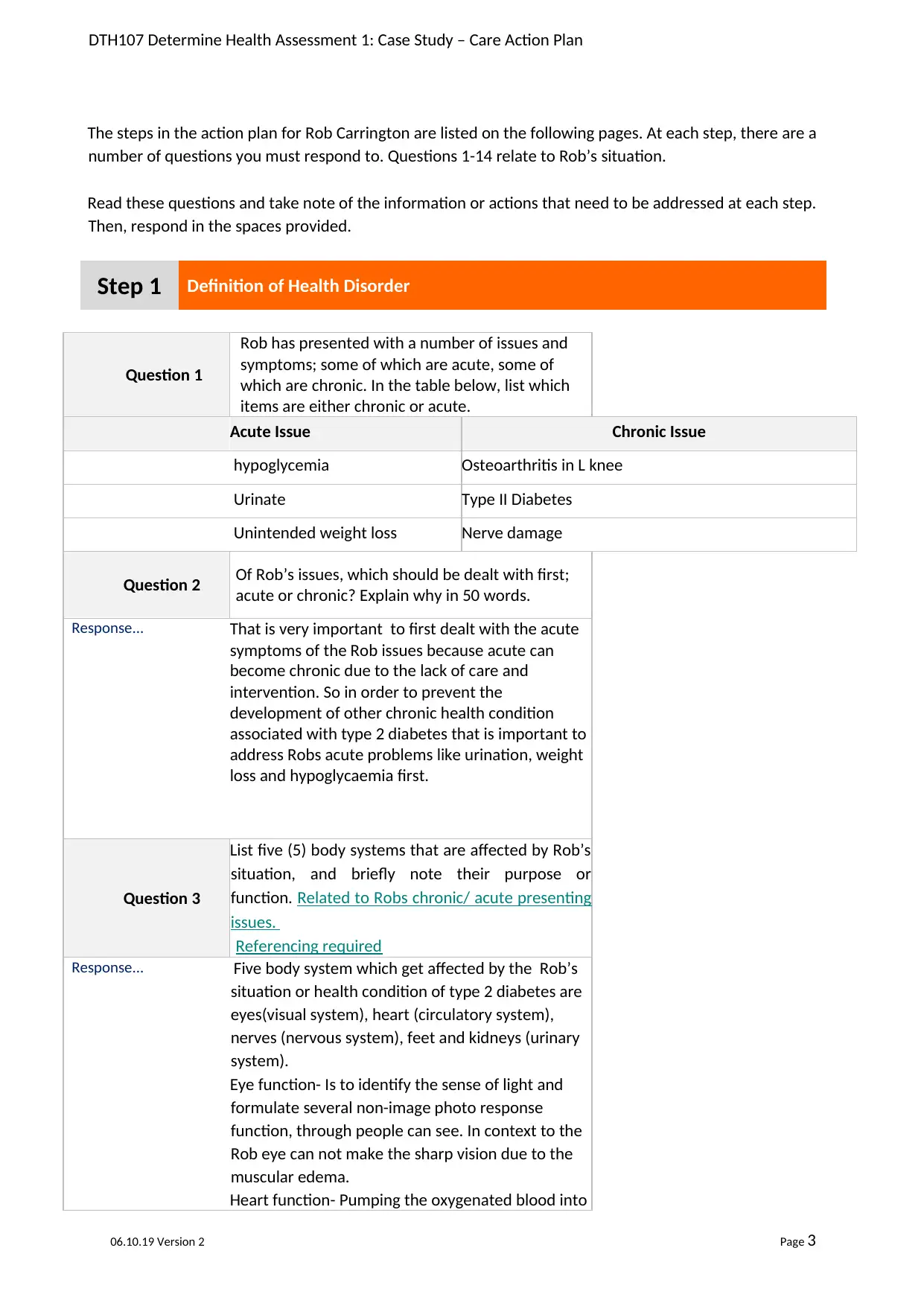
DTH107 Determine Health Assessment 1: Case Study – Care Action Plan
The steps in the action plan for Rob Carrington are listed on the following pages. At each step, there are a
number of questions you must respond to. Questions 1-14 relate to Rob’s situation.
Read these questions and take note of the information or actions that need to be addressed at each step.
Then, respond in the spaces provided.
Step 1 Definition of Health Disorder
Question 1
Rob has presented with a number of issues and
symptoms; some of which are acute, some of
which are chronic. In the table below, list which
items are either chronic or acute.
Acute Issue Chronic Issue
hypoglycemia Osteoarthritis in L knee
Urinate Type II Diabetes
Unintended weight loss Nerve damage
Question 2 Of Rob’s issues, which should be dealt with first;
acute or chronic? Explain why in 50 words.
Response... That is very important to first dealt with the acute
symptoms of the Rob issues because acute can
become chronic due to the lack of care and
intervention. So in order to prevent the
development of other chronic health condition
associated with type 2 diabetes that is important to
address Robs acute problems like urination, weight
loss and hypoglycaemia first.
Question 3
List five (5) body systems that are affected by Rob’s
situation, and briefly note their purpose or
function. Related to Robs chronic/ acute presenting
issues.
Referencing required
Response... Five body system which get affected by the Rob’s
situation or health condition of type 2 diabetes are
eyes(visual system), heart (circulatory system),
nerves (nervous system), feet and kidneys (urinary
system).
Eye function- Is to identify the sense of light and
formulate several non-image photo response
function, through people can see. In context to the
Rob eye can not make the sharp vision due to the
muscular edema.
Heart function- Pumping the oxygenated blood into
06.10.19 Version 2 Page 3
The steps in the action plan for Rob Carrington are listed on the following pages. At each step, there are a
number of questions you must respond to. Questions 1-14 relate to Rob’s situation.
Read these questions and take note of the information or actions that need to be addressed at each step.
Then, respond in the spaces provided.
Step 1 Definition of Health Disorder
Question 1
Rob has presented with a number of issues and
symptoms; some of which are acute, some of
which are chronic. In the table below, list which
items are either chronic or acute.
Acute Issue Chronic Issue
hypoglycemia Osteoarthritis in L knee
Urinate Type II Diabetes
Unintended weight loss Nerve damage
Question 2 Of Rob’s issues, which should be dealt with first;
acute or chronic? Explain why in 50 words.
Response... That is very important to first dealt with the acute
symptoms of the Rob issues because acute can
become chronic due to the lack of care and
intervention. So in order to prevent the
development of other chronic health condition
associated with type 2 diabetes that is important to
address Robs acute problems like urination, weight
loss and hypoglycaemia first.
Question 3
List five (5) body systems that are affected by Rob’s
situation, and briefly note their purpose or
function. Related to Robs chronic/ acute presenting
issues.
Referencing required
Response... Five body system which get affected by the Rob’s
situation or health condition of type 2 diabetes are
eyes(visual system), heart (circulatory system),
nerves (nervous system), feet and kidneys (urinary
system).
Eye function- Is to identify the sense of light and
formulate several non-image photo response
function, through people can see. In context to the
Rob eye can not make the sharp vision due to the
muscular edema.
Heart function- Pumping the oxygenated blood into
06.10.19 Version 2 Page 3
⊘ This is a preview!⊘
Do you want full access?
Subscribe today to unlock all pages.

Trusted by 1+ million students worldwide
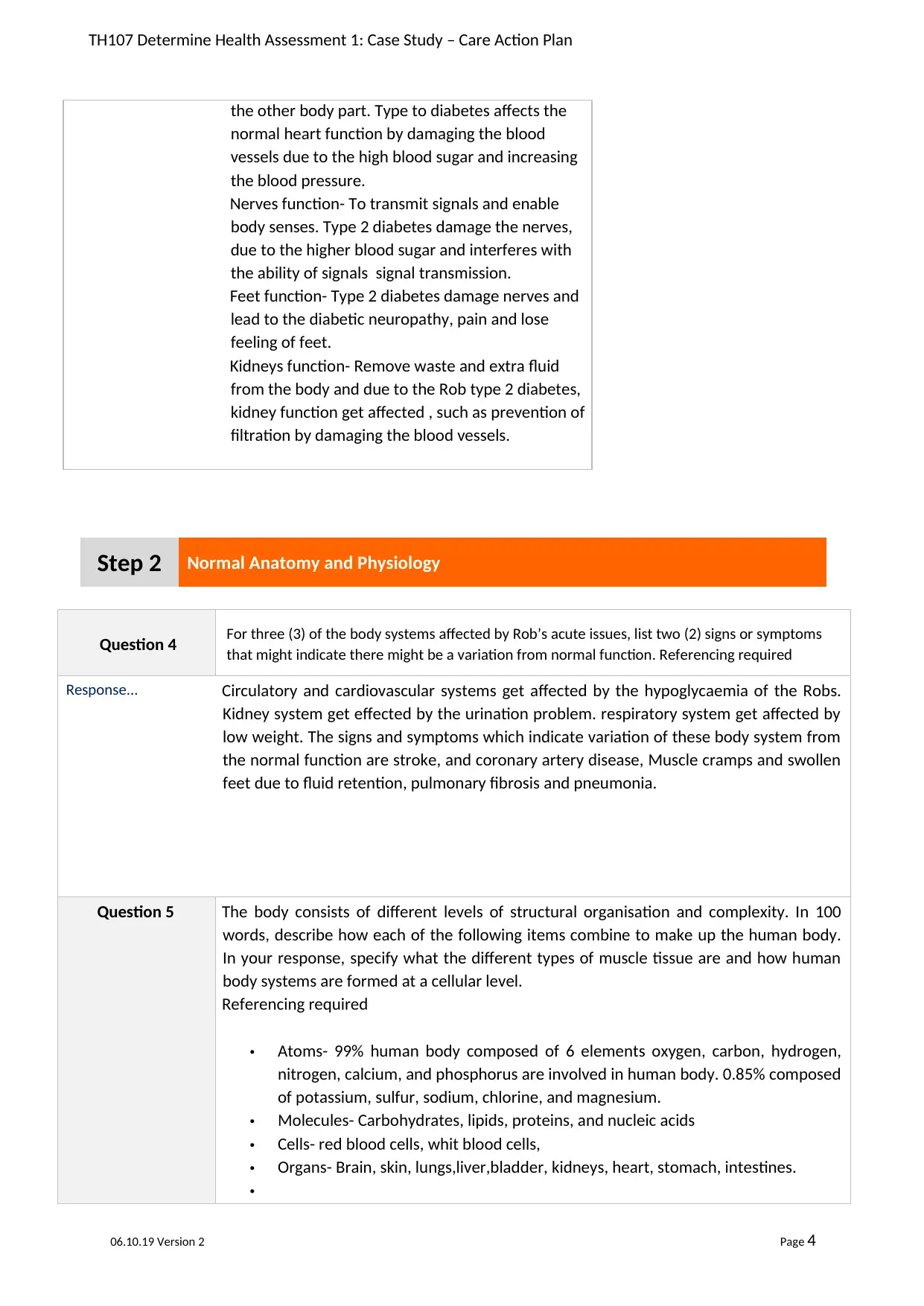
TH107 Determine Health Assessment 1: Case Study – Care Action Plan
the other body part. Type to diabetes affects the
normal heart function by damaging the blood
vessels due to the high blood sugar and increasing
the blood pressure.
Nerves function- To transmit signals and enable
body senses. Type 2 diabetes damage the nerves,
due to the higher blood sugar and interferes with
the ability of signals signal transmission.
Feet function- Type 2 diabetes damage nerves and
lead to the diabetic neuropathy, pain and lose
feeling of feet.
Kidneys function- Remove waste and extra fluid
from the body and due to the Rob type 2 diabetes,
kidney function get affected , such as prevention of
filtration by damaging the blood vessels.
Step 2 Normal Anatomy and Physiology
Question 4 For three (3) of the body systems affected by Rob’s acute issues, list two (2) signs or symptoms
that might indicate there might be a variation from normal function. Referencing required
Response... Circulatory and cardiovascular systems get affected by the hypoglycaemia of the Robs.
Kidney system get effected by the urination problem. respiratory system get affected by
low weight. The signs and symptoms which indicate variation of these body system from
the normal function are stroke, and coronary artery disease, Muscle cramps and swollen
feet due to fluid retention, pulmonary fibrosis and pneumonia.
Question 5 The body consists of different levels of structural organisation and complexity. In 100
words, describe how each of the following items combine to make up the human body.
In your response, specify what the different types of muscle tissue are and how human
body systems are formed at a cellular level.
Referencing required
• Atoms- 99% human body composed of 6 elements oxygen, carbon, hydrogen,
nitrogen, calcium, and phosphorus are involved in human body. 0.85% composed
of potassium, sulfur, sodium, chlorine, and magnesium.
• Molecules- Carbohydrates, lipids, proteins, and nucleic acids
• Cells- red blood cells, whit blood cells,
• Organs- Brain, skin, lungs,liver,bladder, kidneys, heart, stomach, intestines.
•
06.10.19 Version 2 Page 4
the other body part. Type to diabetes affects the
normal heart function by damaging the blood
vessels due to the high blood sugar and increasing
the blood pressure.
Nerves function- To transmit signals and enable
body senses. Type 2 diabetes damage the nerves,
due to the higher blood sugar and interferes with
the ability of signals signal transmission.
Feet function- Type 2 diabetes damage nerves and
lead to the diabetic neuropathy, pain and lose
feeling of feet.
Kidneys function- Remove waste and extra fluid
from the body and due to the Rob type 2 diabetes,
kidney function get affected , such as prevention of
filtration by damaging the blood vessels.
Step 2 Normal Anatomy and Physiology
Question 4 For three (3) of the body systems affected by Rob’s acute issues, list two (2) signs or symptoms
that might indicate there might be a variation from normal function. Referencing required
Response... Circulatory and cardiovascular systems get affected by the hypoglycaemia of the Robs.
Kidney system get effected by the urination problem. respiratory system get affected by
low weight. The signs and symptoms which indicate variation of these body system from
the normal function are stroke, and coronary artery disease, Muscle cramps and swollen
feet due to fluid retention, pulmonary fibrosis and pneumonia.
Question 5 The body consists of different levels of structural organisation and complexity. In 100
words, describe how each of the following items combine to make up the human body.
In your response, specify what the different types of muscle tissue are and how human
body systems are formed at a cellular level.
Referencing required
• Atoms- 99% human body composed of 6 elements oxygen, carbon, hydrogen,
nitrogen, calcium, and phosphorus are involved in human body. 0.85% composed
of potassium, sulfur, sodium, chlorine, and magnesium.
• Molecules- Carbohydrates, lipids, proteins, and nucleic acids
• Cells- red blood cells, whit blood cells,
• Organs- Brain, skin, lungs,liver,bladder, kidneys, heart, stomach, intestines.
•
06.10.19 Version 2 Page 4
Paraphrase This Document
Need a fresh take? Get an instant paraphrase of this document with our AI Paraphraser
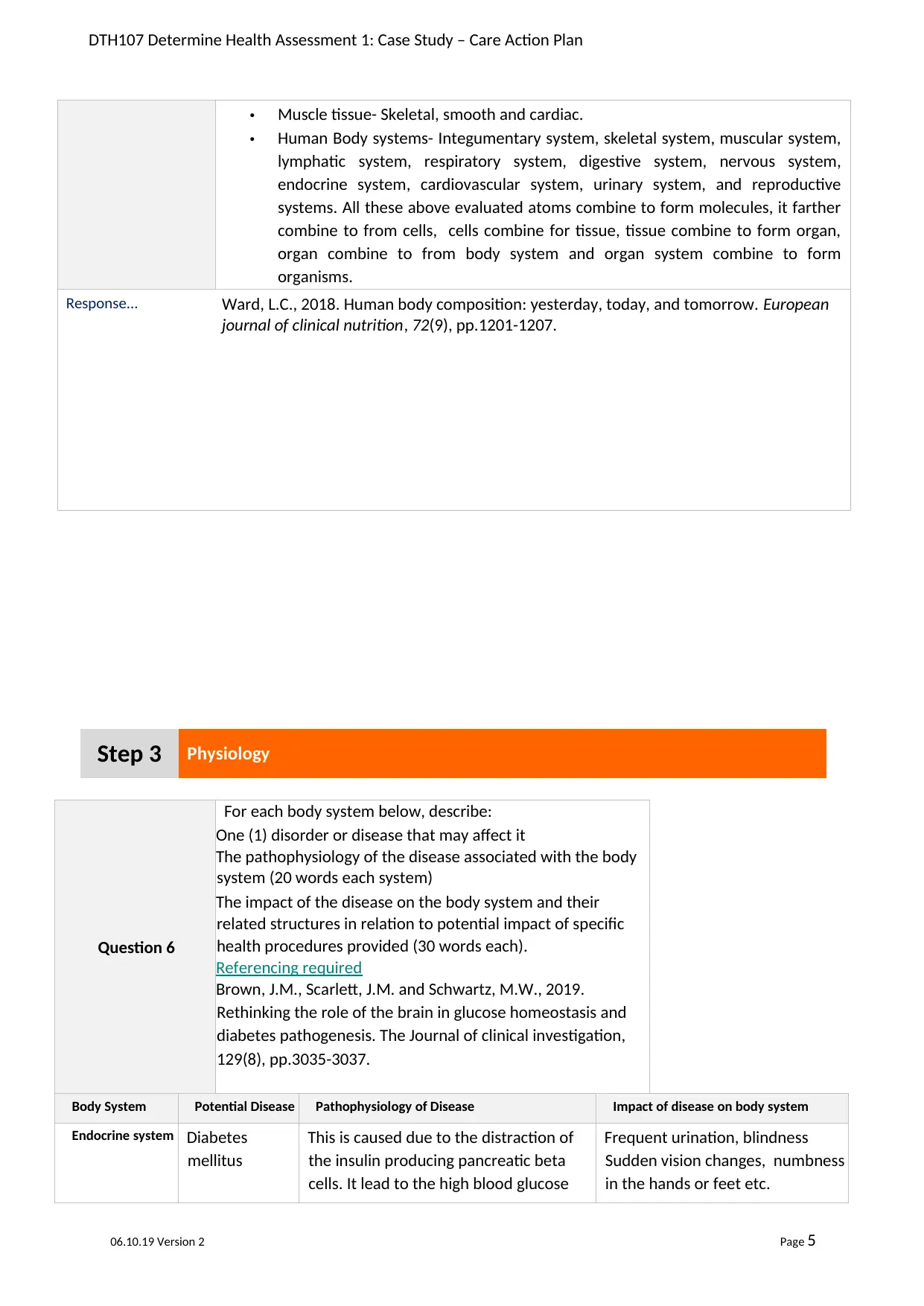
DTH107 Determine Health Assessment 1: Case Study – Care Action Plan
• Muscle tissue- Skeletal, smooth and cardiac.
• Human Body systems- Integumentary system, skeletal system, muscular system,
lymphatic system, respiratory system, digestive system, nervous system,
endocrine system, cardiovascular system, urinary system, and reproductive
systems. All these above evaluated atoms combine to form molecules, it farther
combine to from cells, cells combine for tissue, tissue combine to form organ,
organ combine to from body system and organ system combine to form
organisms.
Response... Ward, L.C., 2018. Human body composition: yesterday, today, and tomorrow. European
journal of clinical nutrition, 72(9), pp.1201-1207.
Step 3 Physiology
Question 6
For each body system below, describe:
One (1) disorder or disease that may affect it
The pathophysiology of the disease associated with the body
system (20 words each system)
The impact of the disease on the body system and their
related structures in relation to potential impact of specific
health procedures provided (30 words each).
Referencing required
Brown, J.M., Scarlett, J.M. and Schwartz, M.W., 2019.
Rethinking the role of the brain in glucose homeostasis and
diabetes pathogenesis. The Journal of clinical investigation,
129(8), pp.3035-3037.
Body System Potential Disease Pathophysiology of Disease Impact of disease on body system
Endocrine system Diabetes
mellitus
This is caused due to the distraction of
the insulin producing pancreatic beta
cells. It lead to the high blood glucose
Frequent urination, blindness
Sudden vision changes, numbness
in the hands or feet etc.
06.10.19 Version 2 Page 5
• Muscle tissue- Skeletal, smooth and cardiac.
• Human Body systems- Integumentary system, skeletal system, muscular system,
lymphatic system, respiratory system, digestive system, nervous system,
endocrine system, cardiovascular system, urinary system, and reproductive
systems. All these above evaluated atoms combine to form molecules, it farther
combine to from cells, cells combine for tissue, tissue combine to form organ,
organ combine to from body system and organ system combine to form
organisms.
Response... Ward, L.C., 2018. Human body composition: yesterday, today, and tomorrow. European
journal of clinical nutrition, 72(9), pp.1201-1207.
Step 3 Physiology
Question 6
For each body system below, describe:
One (1) disorder or disease that may affect it
The pathophysiology of the disease associated with the body
system (20 words each system)
The impact of the disease on the body system and their
related structures in relation to potential impact of specific
health procedures provided (30 words each).
Referencing required
Brown, J.M., Scarlett, J.M. and Schwartz, M.W., 2019.
Rethinking the role of the brain in glucose homeostasis and
diabetes pathogenesis. The Journal of clinical investigation,
129(8), pp.3035-3037.
Body System Potential Disease Pathophysiology of Disease Impact of disease on body system
Endocrine system Diabetes
mellitus
This is caused due to the distraction of
the insulin producing pancreatic beta
cells. It lead to the high blood glucose
Frequent urination, blindness
Sudden vision changes, numbness
in the hands or feet etc.
06.10.19 Version 2 Page 5
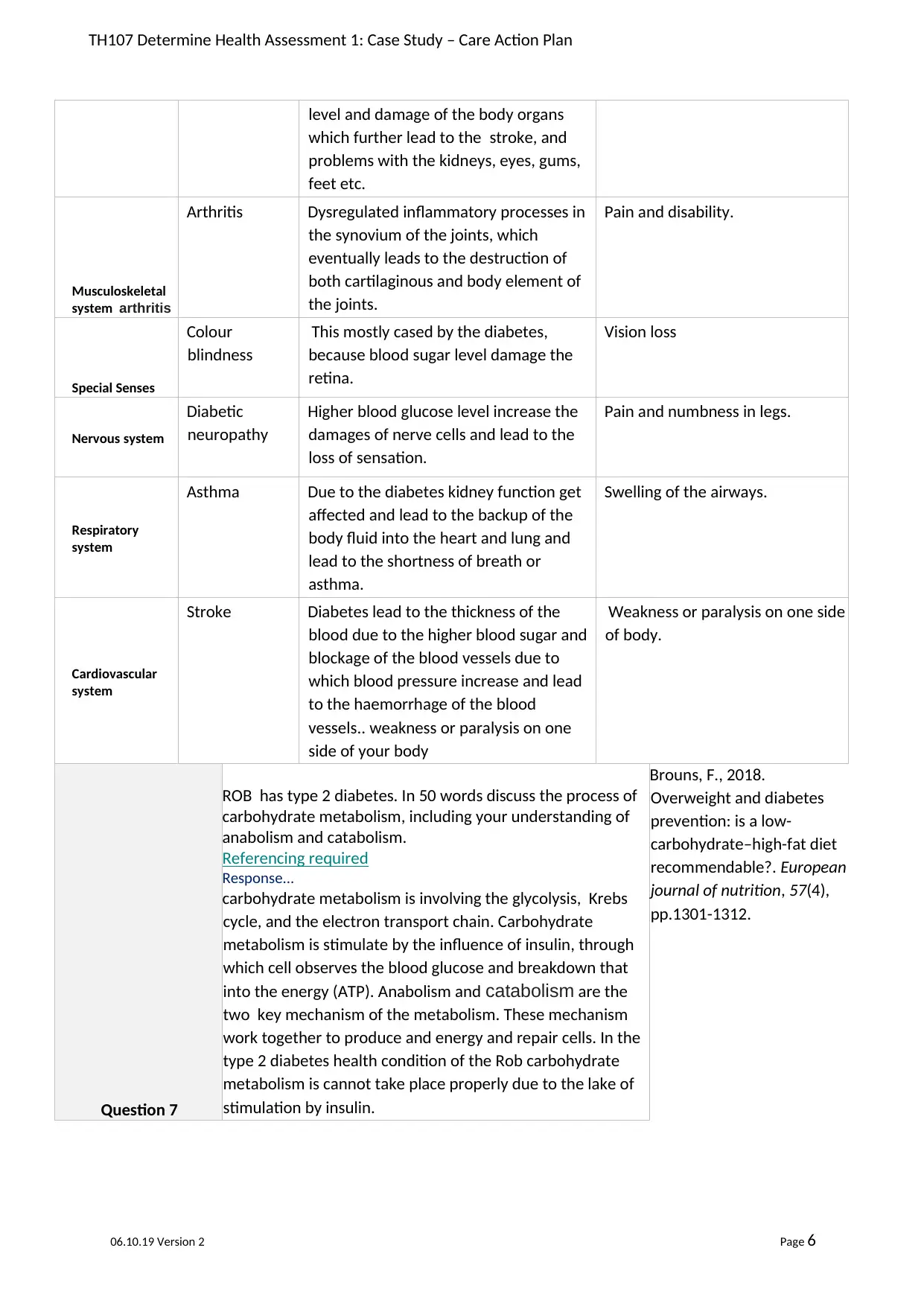
TH107 Determine Health Assessment 1: Case Study – Care Action Plan
level and damage of the body organs
which further lead to the stroke, and
problems with the kidneys, eyes, gums,
feet etc.
Musculoskeletal
system arthritis
Arthritis Dysregulated inflammatory processes in
the synovium of the joints, which
eventually leads to the destruction of
both cartilaginous and body element of
the joints.
Pain and disability.
Special Senses
Colour
blindness
This mostly cased by the diabetes,
because blood sugar level damage the
retina.
Vision loss
Nervous system
Diabetic
neuropathy
Higher blood glucose level increase the
damages of nerve cells and lead to the
loss of sensation.
Pain and numbness in legs.
Respiratory
system
Asthma Due to the diabetes kidney function get
affected and lead to the backup of the
body fluid into the heart and lung and
lead to the shortness of breath or
asthma.
Swelling of the airways.
Cardiovascular
system
Stroke Diabetes lead to the thickness of the
blood due to the higher blood sugar and
blockage of the blood vessels due to
which blood pressure increase and lead
to the haemorrhage of the blood
vessels.. weakness or paralysis on one
side of your body
Weakness or paralysis on one side
of body.
Question 7
ROB has type 2 diabetes. In 50 words discuss the process of
carbohydrate metabolism, including your understanding of
anabolism and catabolism.
Referencing required
Response...
carbohydrate metabolism is involving the glycolysis, Krebs
cycle, and the electron transport chain. Carbohydrate
metabolism is stimulate by the influence of insulin, through
which cell observes the blood glucose and breakdown that
into the energy (ATP). Anabolism and catabolism are the
two key mechanism of the metabolism. These mechanism
work together to produce and energy and repair cells. In the
type 2 diabetes health condition of the Rob carbohydrate
metabolism is cannot take place properly due to the lake of
stimulation by insulin.
Brouns, F., 2018.
Overweight and diabetes
prevention: is a low-
carbohydrate–high-fat diet
recommendable?. European
journal of nutrition, 57(4),
pp.1301-1312.
06.10.19 Version 2 Page 6
level and damage of the body organs
which further lead to the stroke, and
problems with the kidneys, eyes, gums,
feet etc.
Musculoskeletal
system arthritis
Arthritis Dysregulated inflammatory processes in
the synovium of the joints, which
eventually leads to the destruction of
both cartilaginous and body element of
the joints.
Pain and disability.
Special Senses
Colour
blindness
This mostly cased by the diabetes,
because blood sugar level damage the
retina.
Vision loss
Nervous system
Diabetic
neuropathy
Higher blood glucose level increase the
damages of nerve cells and lead to the
loss of sensation.
Pain and numbness in legs.
Respiratory
system
Asthma Due to the diabetes kidney function get
affected and lead to the backup of the
body fluid into the heart and lung and
lead to the shortness of breath or
asthma.
Swelling of the airways.
Cardiovascular
system
Stroke Diabetes lead to the thickness of the
blood due to the higher blood sugar and
blockage of the blood vessels due to
which blood pressure increase and lead
to the haemorrhage of the blood
vessels.. weakness or paralysis on one
side of your body
Weakness or paralysis on one side
of body.
Question 7
ROB has type 2 diabetes. In 50 words discuss the process of
carbohydrate metabolism, including your understanding of
anabolism and catabolism.
Referencing required
Response...
carbohydrate metabolism is involving the glycolysis, Krebs
cycle, and the electron transport chain. Carbohydrate
metabolism is stimulate by the influence of insulin, through
which cell observes the blood glucose and breakdown that
into the energy (ATP). Anabolism and catabolism are the
two key mechanism of the metabolism. These mechanism
work together to produce and energy and repair cells. In the
type 2 diabetes health condition of the Rob carbohydrate
metabolism is cannot take place properly due to the lake of
stimulation by insulin.
Brouns, F., 2018.
Overweight and diabetes
prevention: is a low-
carbohydrate–high-fat diet
recommendable?. European
journal of nutrition, 57(4),
pp.1301-1312.
06.10.19 Version 2 Page 6
⊘ This is a preview!⊘
Do you want full access?
Subscribe today to unlock all pages.

Trusted by 1+ million students worldwide
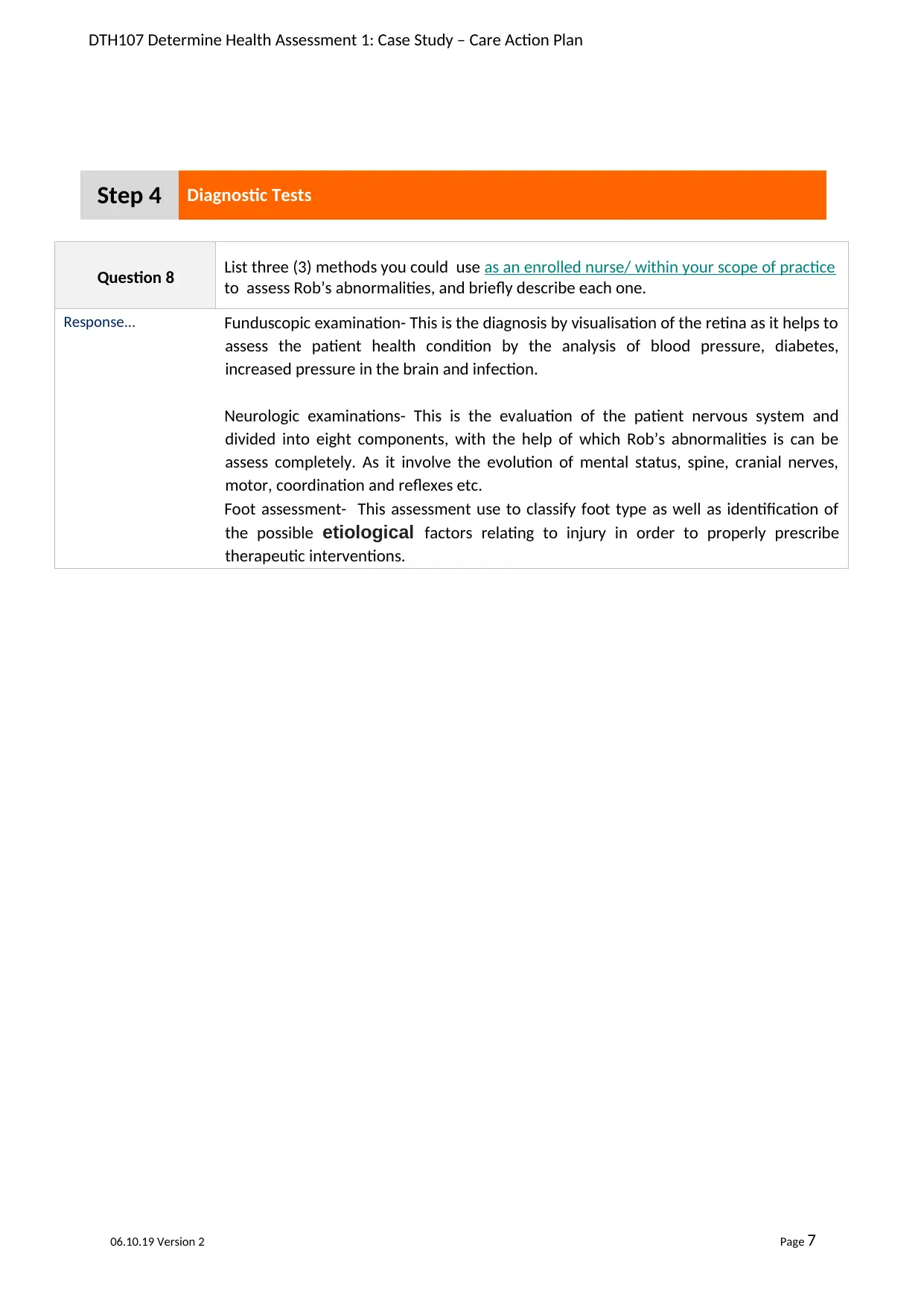
DTH107 Determine Health Assessment 1: Case Study – Care Action Plan
Step 4 Diagnostic Tests
Question 8 List three (3) methods you could use as an enrolled nurse/ within your scope of practice
to assess Rob’s abnormalities, and briefly describe each one.
Response... Funduscopic examination- This is the diagnosis by visualisation of the retina as it helps to
assess the patient health condition by the analysis of blood pressure, diabetes,
increased pressure in the brain and infection.
Neurologic examinations- This is the evaluation of the patient nervous system and
divided into eight components, with the help of which Rob’s abnormalities is can be
assess completely. As it involve the evolution of mental status, spine, cranial nerves,
motor, coordination and reflexes etc.
Foot assessment- This assessment use to classify foot type as well as identification of
the possible etiological factors relating to injury in order to properly prescribe
therapeutic interventions.
06.10.19 Version 2 Page 7
Step 4 Diagnostic Tests
Question 8 List three (3) methods you could use as an enrolled nurse/ within your scope of practice
to assess Rob’s abnormalities, and briefly describe each one.
Response... Funduscopic examination- This is the diagnosis by visualisation of the retina as it helps to
assess the patient health condition by the analysis of blood pressure, diabetes,
increased pressure in the brain and infection.
Neurologic examinations- This is the evaluation of the patient nervous system and
divided into eight components, with the help of which Rob’s abnormalities is can be
assess completely. As it involve the evolution of mental status, spine, cranial nerves,
motor, coordination and reflexes etc.
Foot assessment- This assessment use to classify foot type as well as identification of
the possible etiological factors relating to injury in order to properly prescribe
therapeutic interventions.
06.10.19 Version 2 Page 7
Paraphrase This Document
Need a fresh take? Get an instant paraphrase of this document with our AI Paraphraser
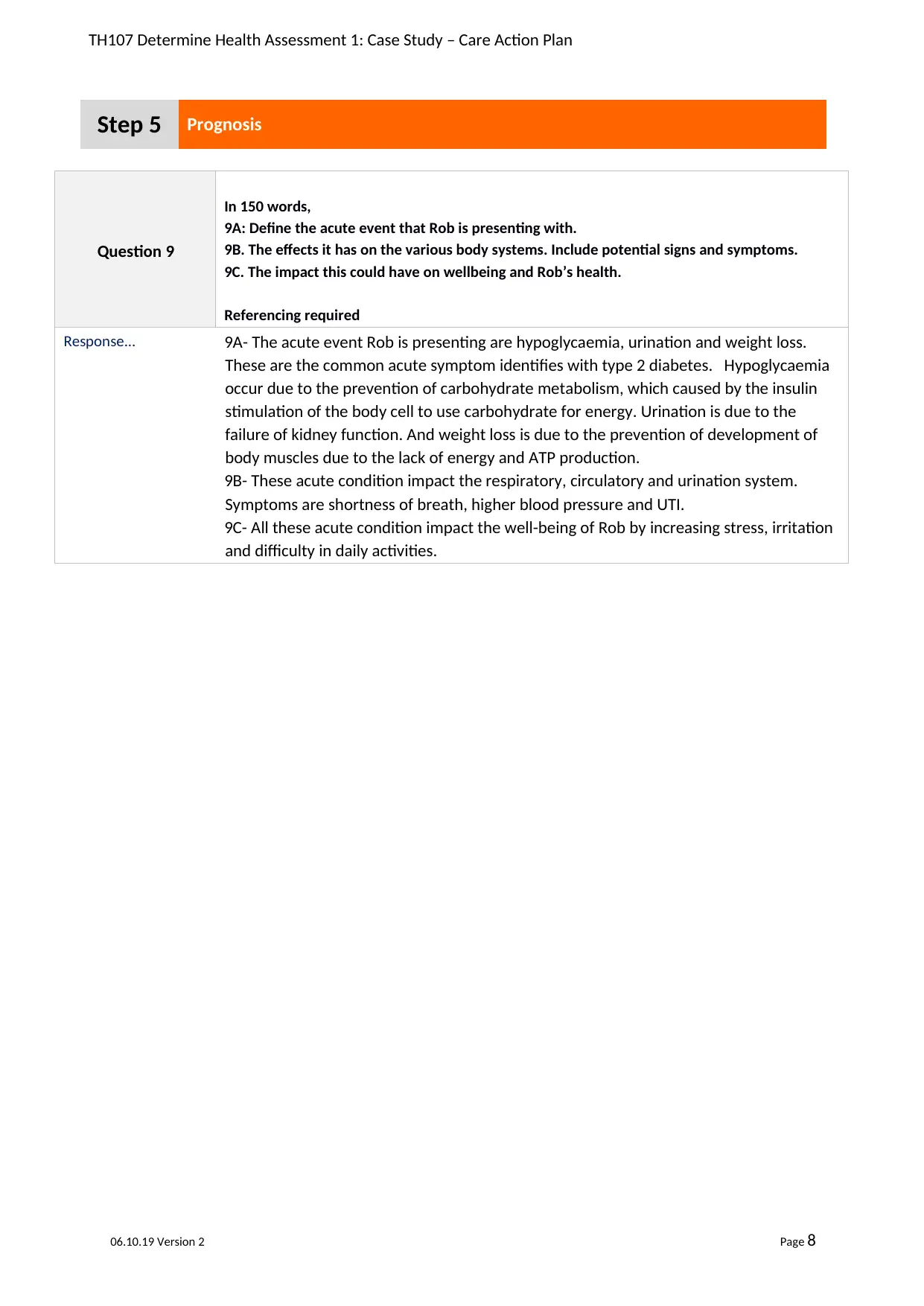
TH107 Determine Health Assessment 1: Case Study – Care Action Plan
Step 5 Prognosis
Question 9
In 150 words,
9A: Define the acute event that Rob is presenting with.
9B. The effects it has on the various body systems. Include potential signs and symptoms.
9C. The impact this could have on wellbeing and Rob’s health.
Referencing required
Response... 9A- The acute event Rob is presenting are hypoglycaemia, urination and weight loss.
These are the common acute symptom identifies with type 2 diabetes. Hypoglycaemia
occur due to the prevention of carbohydrate metabolism, which caused by the insulin
stimulation of the body cell to use carbohydrate for energy. Urination is due to the
failure of kidney function. And weight loss is due to the prevention of development of
body muscles due to the lack of energy and ATP production.
9B- These acute condition impact the respiratory, circulatory and urination system.
Symptoms are shortness of breath, higher blood pressure and UTI.
9C- All these acute condition impact the well-being of Rob by increasing stress, irritation
and difficulty in daily activities.
06.10.19 Version 2 Page 8
Step 5 Prognosis
Question 9
In 150 words,
9A: Define the acute event that Rob is presenting with.
9B. The effects it has on the various body systems. Include potential signs and symptoms.
9C. The impact this could have on wellbeing and Rob’s health.
Referencing required
Response... 9A- The acute event Rob is presenting are hypoglycaemia, urination and weight loss.
These are the common acute symptom identifies with type 2 diabetes. Hypoglycaemia
occur due to the prevention of carbohydrate metabolism, which caused by the insulin
stimulation of the body cell to use carbohydrate for energy. Urination is due to the
failure of kidney function. And weight loss is due to the prevention of development of
body muscles due to the lack of energy and ATP production.
9B- These acute condition impact the respiratory, circulatory and urination system.
Symptoms are shortness of breath, higher blood pressure and UTI.
9C- All these acute condition impact the well-being of Rob by increasing stress, irritation
and difficulty in daily activities.
06.10.19 Version 2 Page 8
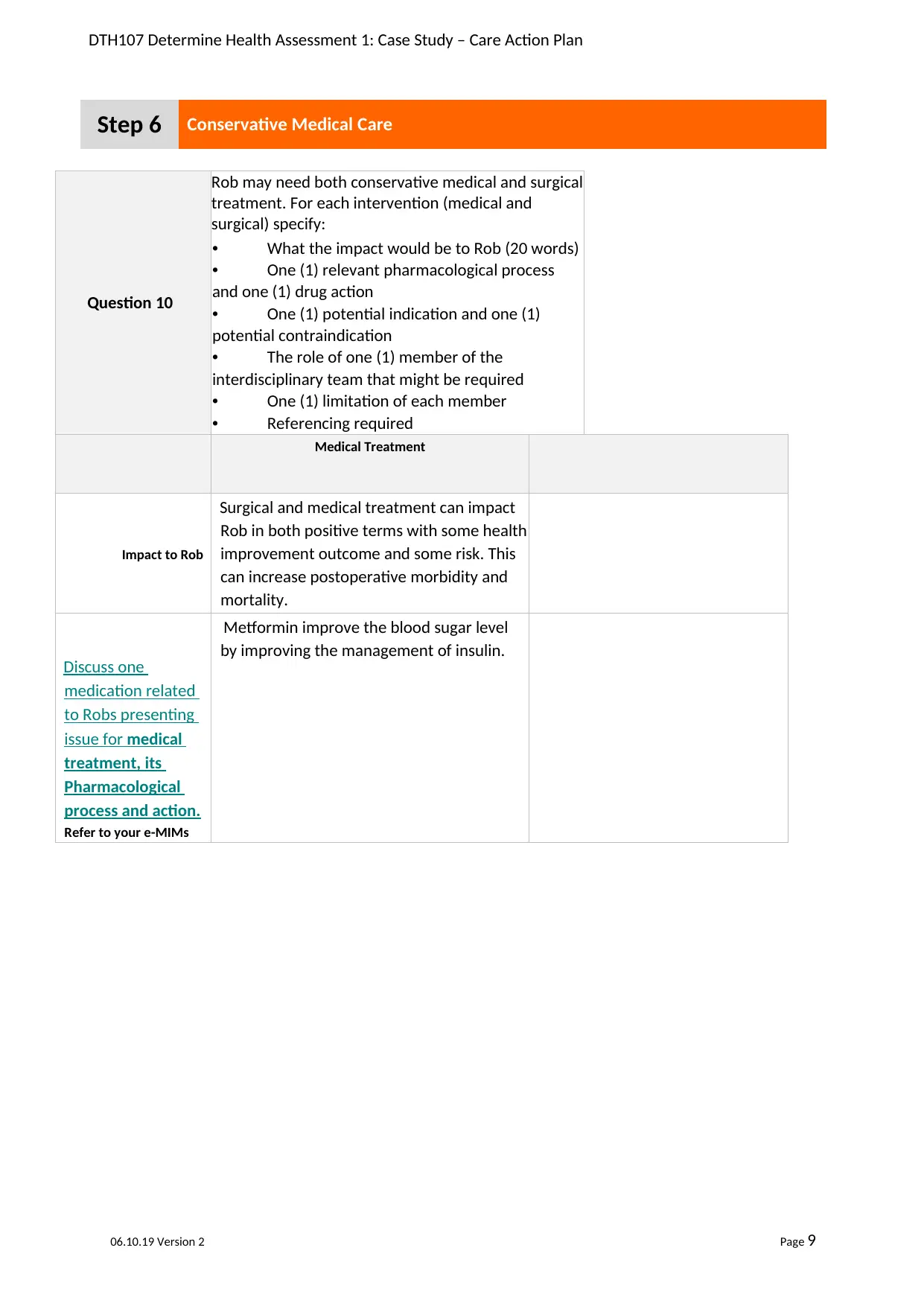
DTH107 Determine Health Assessment 1: Case Study – Care Action Plan
Step 6 Conservative Medical Care
Question 10
Rob may need both conservative medical and surgical
treatment. For each intervention (medical and
surgical) specify:
• What the impact would be to Rob (20 words)
• One (1) relevant pharmacological process
and one (1) drug action
• One (1) potential indication and one (1)
potential contraindication
• The role of one (1) member of the
interdisciplinary team that might be required
• One (1) limitation of each member
• Referencing required
Medical Treatment
Impact to Rob
Surgical and medical treatment can impact
Rob in both positive terms with some health
improvement outcome and some risk. This
can increase postoperative morbidity and
mortality.
Discuss one
medication related
to Robs presenting
issue for medical
treatment, its
Pharmacological
process and action.
Refer to your e-MIMs
Metformin improve the blood sugar level
by improving the management of insulin.
06.10.19 Version 2 Page 9
Step 6 Conservative Medical Care
Question 10
Rob may need both conservative medical and surgical
treatment. For each intervention (medical and
surgical) specify:
• What the impact would be to Rob (20 words)
• One (1) relevant pharmacological process
and one (1) drug action
• One (1) potential indication and one (1)
potential contraindication
• The role of one (1) member of the
interdisciplinary team that might be required
• One (1) limitation of each member
• Referencing required
Medical Treatment
Impact to Rob
Surgical and medical treatment can impact
Rob in both positive terms with some health
improvement outcome and some risk. This
can increase postoperative morbidity and
mortality.
Discuss one
medication related
to Robs presenting
issue for medical
treatment, its
Pharmacological
process and action.
Refer to your e-MIMs
Metformin improve the blood sugar level
by improving the management of insulin.
06.10.19 Version 2 Page 9
⊘ This is a preview!⊘
Do you want full access?
Subscribe today to unlock all pages.

Trusted by 1+ million students worldwide
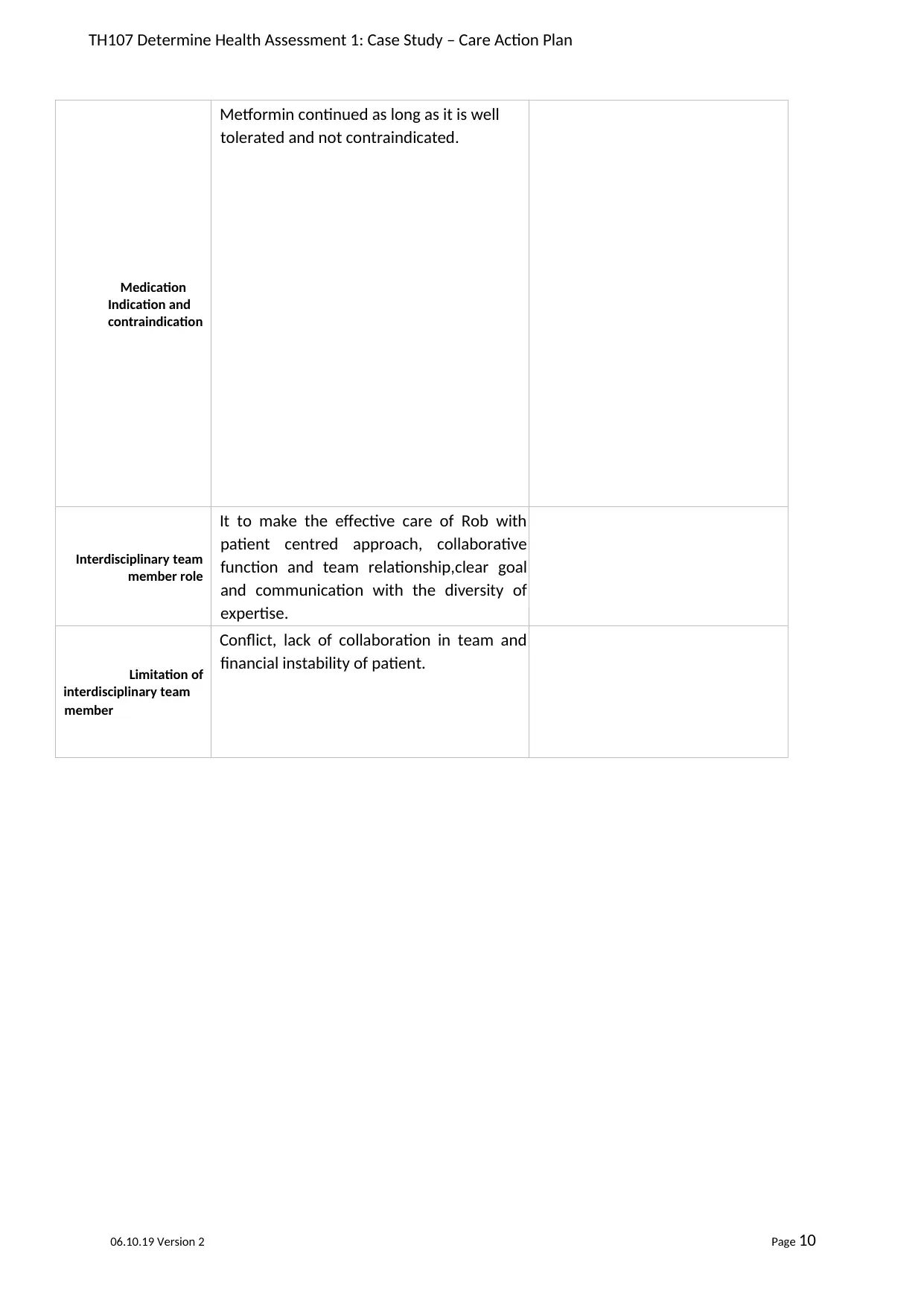
TH107 Determine Health Assessment 1: Case Study – Care Action Plan
Medication
Indication and
contraindication
Metformin continued as long as it is well
tolerated and not contraindicated.
Interdisciplinary team
member role
It to make the effective care of Rob with
patient centred approach, collaborative
function and team relationship,clear goal
and communication with the diversity of
expertise.
Limitation of
interdisciplinary team
member
Conflict, lack of collaboration in team and
financial instability of patient.
06.10.19 Version 2 Page 10
Medication
Indication and
contraindication
Metformin continued as long as it is well
tolerated and not contraindicated.
Interdisciplinary team
member role
It to make the effective care of Rob with
patient centred approach, collaborative
function and team relationship,clear goal
and communication with the diversity of
expertise.
Limitation of
interdisciplinary team
member
Conflict, lack of collaboration in team and
financial instability of patient.
06.10.19 Version 2 Page 10
Paraphrase This Document
Need a fresh take? Get an instant paraphrase of this document with our AI Paraphraser
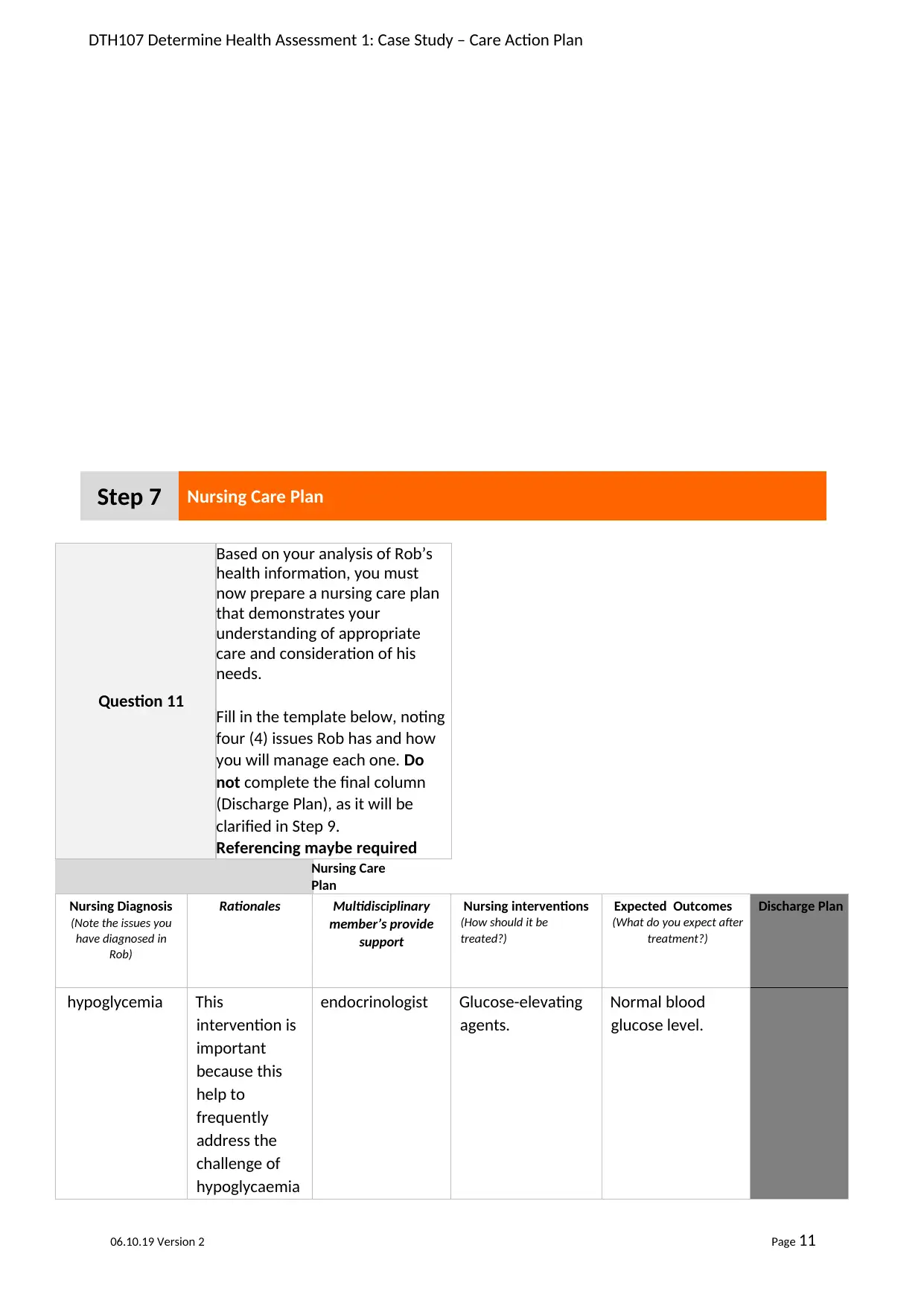
DTH107 Determine Health Assessment 1: Case Study – Care Action Plan
Step 7 Nursing Care Plan
Question 11
Based on your analysis of Rob’s
health information, you must
now prepare a nursing care plan
that demonstrates your
understanding of appropriate
care and consideration of his
needs.
Fill in the template below, noting
four (4) issues Rob has and how
you will manage each one. Do
not complete the final column
(Discharge Plan), as it will be
clarified in Step 9.
Referencing maybe required
Nursing Care
Plan
Nursing Diagnosis
(Note the issues you
have diagnosed in
Rob)
Rationales Multidisciplinary
member’s provide
support
Nursing interventions
(How should it be
treated?)
Expected Outcomes
(What do you expect after
treatment?)
Discharge Plan
hypoglycemia This
intervention is
important
because this
help to
frequently
address the
challenge of
hypoglycaemia
endocrinologist Glucose-elevating
agents.
Normal blood
glucose level.
06.10.19 Version 2 Page 11
Step 7 Nursing Care Plan
Question 11
Based on your analysis of Rob’s
health information, you must
now prepare a nursing care plan
that demonstrates your
understanding of appropriate
care and consideration of his
needs.
Fill in the template below, noting
four (4) issues Rob has and how
you will manage each one. Do
not complete the final column
(Discharge Plan), as it will be
clarified in Step 9.
Referencing maybe required
Nursing Care
Plan
Nursing Diagnosis
(Note the issues you
have diagnosed in
Rob)
Rationales Multidisciplinary
member’s provide
support
Nursing interventions
(How should it be
treated?)
Expected Outcomes
(What do you expect after
treatment?)
Discharge Plan
hypoglycemia This
intervention is
important
because this
help to
frequently
address the
challenge of
hypoglycaemia
endocrinologist Glucose-elevating
agents.
Normal blood
glucose level.
06.10.19 Version 2 Page 11
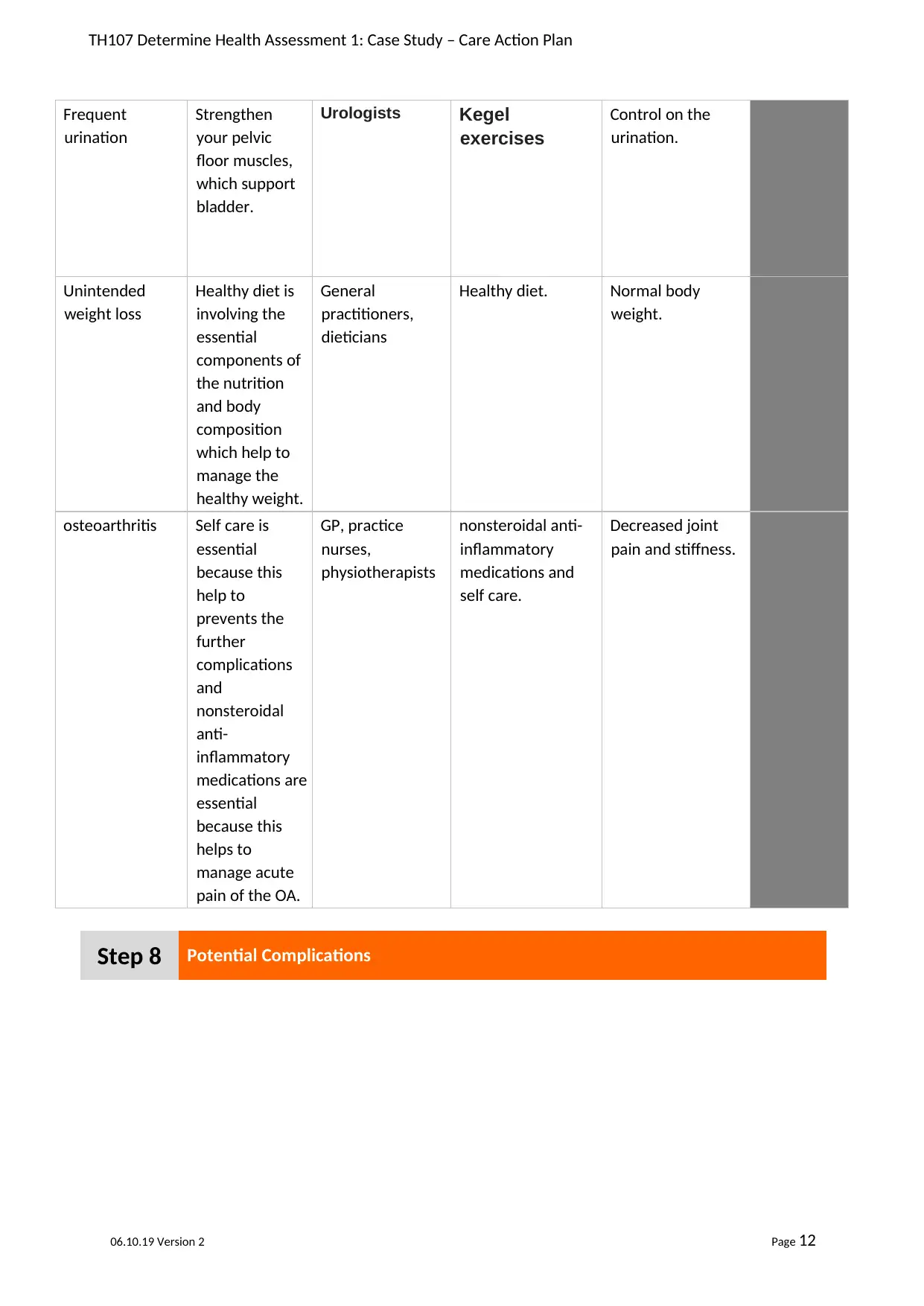
TH107 Determine Health Assessment 1: Case Study – Care Action Plan
Frequent
urination
Strengthen
your pelvic
floor muscles,
which support
bladder.
Urologists Kegel
exercises
Control on the
urination.
Unintended
weight loss
Healthy diet is
involving the
essential
components of
the nutrition
and body
composition
which help to
manage the
healthy weight.
General
practitioners,
dieticians
Healthy diet. Normal body
weight.
osteoarthritis Self care is
essential
because this
help to
prevents the
further
complications
and
nonsteroidal
anti-
inflammatory
medications are
essential
because this
helps to
manage acute
pain of the OA.
GP, practice
nurses,
physiotherapists
nonsteroidal anti-
inflammatory
medications and
self care.
Decreased joint
pain and stiffness.
Step 8 Potential Complications
06.10.19 Version 2 Page 12
Frequent
urination
Strengthen
your pelvic
floor muscles,
which support
bladder.
Urologists Kegel
exercises
Control on the
urination.
Unintended
weight loss
Healthy diet is
involving the
essential
components of
the nutrition
and body
composition
which help to
manage the
healthy weight.
General
practitioners,
dieticians
Healthy diet. Normal body
weight.
osteoarthritis Self care is
essential
because this
help to
prevents the
further
complications
and
nonsteroidal
anti-
inflammatory
medications are
essential
because this
helps to
manage acute
pain of the OA.
GP, practice
nurses,
physiotherapists
nonsteroidal anti-
inflammatory
medications and
self care.
Decreased joint
pain and stiffness.
Step 8 Potential Complications
06.10.19 Version 2 Page 12
⊘ This is a preview!⊘
Do you want full access?
Subscribe today to unlock all pages.

Trusted by 1+ million students worldwide
1 out of 21
Related Documents
Your All-in-One AI-Powered Toolkit for Academic Success.
+13062052269
info@desklib.com
Available 24*7 on WhatsApp / Email
![[object Object]](/_next/static/media/star-bottom.7253800d.svg)
Unlock your academic potential
Copyright © 2020–2025 A2Z Services. All Rights Reserved. Developed and managed by ZUCOL.





